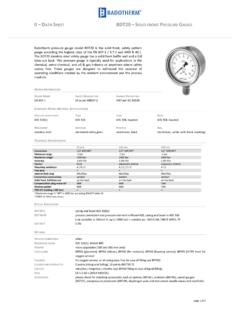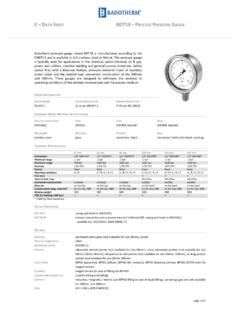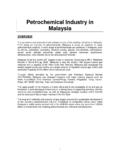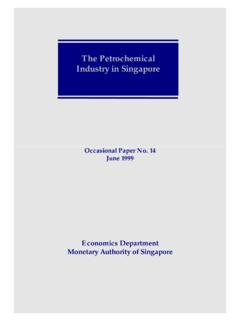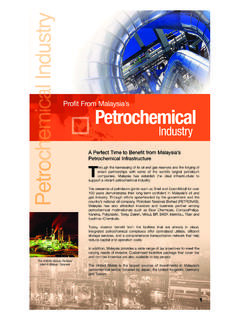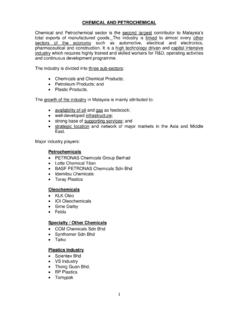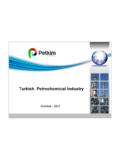Transcription of High Temperature Diaphragm Seal - Badotherm
1 high Temperature Diaphragm SealMeasuring process pressure at 600oCHigh Temperature Diaphragm SealBadotherm Diaphragm Seals are being used in a widearray of industries, to protect the sensitive and vulnerablepressure sensor from the harsh process conditions,such as aggressive and corrosive media, extreme hightemperatures, and viscous media. It is a recognizedphenomenon in the process industry that higher processpressure andhigher process Temperature can improvethe overall , when measuring pressure with transmitterswith Diaphragm Seals, the Temperature limit ofDiaphragm seal applications is set at 410 C, as this isthe maximum allowed Temperature of the filling has developed a new Diaphragm seal thatcan withstand process temperatures up to 600 C.
2 To enable a proper functioning of the Diaphragm Sealat these extreme process temperatures , a patented,revolutionary new design and principle is high Temperature Diaphragm seal (HTDS) isextensively tested in different circumstances and withvarious process temperatures . Typical applicationsfor high temperatures can be found in the chemicalprocess industry , petrochemical industry , and in thethermosolar industry , the latter especially in combinationwith molten salt heat HTDS vs. cooling down the process Temperature to below 400 CTraditional ways of cooling the process medium totemperaturesbelow 400 C are often done by means ofa cooling tower or pipe extension.
3 04006000400 Diaphragm Chamber Temperature (0C)Process Temperature (0C)Normal Diaphragm seal HTDST emperature reduction Diaphragm chamber HTDS vs standard Diaphragm SealPOSSIBILITY TO MEASURE PROCESS PRESSURE AT 600 CAny extension resulting in a longer distance away fromthe actual process media, may result in a pressuremeasurement that is not reflecting the process conditionsaccurately. Still there is a risk that the process temperatureis reaching the Diaphragm seal in the end and hencedestroys the fill fluid when exposed to temperaturesabove 400 C. In case of frequent start-ups, there is thepossibility of air inclusion in the pipe resulting ininaccurate measurements.
4 A cooling tower, often mountedbefore the Diaphragm seal (cooling element, tube orsyphon) often has a small hole of approximately 3 to 4mm, with a high chance of clogging. Further challengesare the dimensions and weight of the total coolingtower construction, also depending of Diaphragm Sealsize and rating, but imagine that a 2 300 RTJ processconnection can be fairly heavy. These vertical installationscan increase the risk of mechanical stress on the towerdue to vibrations. A piping extensionand nozzle (elbowconstruction) has a bigger impact and is more difficult torealize later in the project. It has similar disadvantagesas the cooling tower, where it is even more difficult tocontrol the Temperature at the 'dead end' with heat is the case, when for example the temperatureneeds to be above molten salt solidifying point but alsobelow the filling fluid might not beas much of an issue, but it remains difficult to cleanresidues in the extension of the pipe.
5 Most important isthe additional cost involved for piping department for the(elbow) HTDS operates as a traditional Diaphragm Sealcon-struction,with a built-in mechanical cooling results in a Diaphragm seal that can be mounteddirect to the process to get immediatefeedback andresponse from the process with actual process has far less chance of clogging in this construction can be heat traced until the upperflangefor control of the process Temperature . It is a robustapplication, less prone to mechanical stress whenproperlyinstalled and mounted. There is no heavy equipment or special tooling requiredto install and commission the HTDS and there are noextra costs for piping department to change the and Static Pressure LimitsThe maximum Temperature limit is determined by acombination of the filling fluid, the material of the flangebody and of the bolts used.
6 For an AISI-321H body bolt materials the maximum Temperature is600 C (material specifications and maximum temperatureaccording to the ASME standard). The maximumoperating pressure depends on the flange rating combinedwith process Temperature . The table below presentsthe Temperature and pressure limits for 3 selectedfilling LimitsMax. Process C550 C600 CMin. Ambient C-10 C-40 CMax. Ambient C50 C50 CdP Static PressureMin. (mbarg)125010005000 Max. (bar) maximum process temperatureAccuracy and Other Specifications The table below presents the accuracy specificationsof GP and dP HTDS, as well as the Temperature effects,and pressure Energy and ConcentratingSolar Power Plant Diaphragm seal measurements are common in thethermosolar industry , especially the Concentrating SolarPower Plant (CSP).
7 A CSP Plant produces electricity byusing mirrors to concentrate sunlight onto receiverswhich produce steam to generate electricity. The CSPS ystem consists of three major units:1. Solar Field: Converts solar energy into thermalenergy2. Heat Storage: Stores thermal energy using moltensalt as a heat storage medium3. Power Block: Generates electricity through a steamturbine with steam produced by solar energyTraditional technologies used in a fossil fuel powerplant can be applied to the power block, which utilizessolar thermal energy instead of fossil fuel. Thermalenergy storage is one of the most attractive aspects ofCSP compared with other renewable energy resources,as it allows precise controllability and stability ofelectrical supply even during the hours of CSP is using traditional Diaphragm Sealtechnology with temperatures up to 400 C , the Molten Salt Parabolic Trough CSP (MSPT-CSP) technology, can operate at temperatures up to550 C by changing only the heat transfer fluid from hot-oil to molten salt.
8 The merits of MSPT-CSP system are:1. Higher steam Temperature will achieve higherefficiency in power generation2. Low costs due to less volume required for heatstorage3. Molten salt, used as both heat transfer fluid and heatstorage medium, will allow for a more simplified plantdesign (oil-MS heat exchanger is not required)The HTDS is perfectly suitable for these processconditions and makes it possible to measure pressureat these Diaphragm seal references - Thermosolarindustry: Solnova I, III, IV (Abengoa Solar), Spain Solacor I, II (Abengoa / JGC), Spain Helioenergy I, II (Abengoa / AG Ingeneria), SpainBadotherm HTDS references - Thermosolar industry .
9 Sener - Planta Solar Termoel ctrica Gemasolar, Spain PSA - Plataforma Solar de Almeria,Spain (testing) Abengoa Solar, Spain (testing) Cobra - Crescent Dunes - Tonopah, USA (testing) Universidad de Madrid, Spain (testing)GPdPMin. span required1000 mbar250 mbarTransmitter min. overpressure required40 bar40 barAccuracy2 Span 250 500 >1000 mbar0-25% effectProcess mbar/100C mbar/100 CAmbient temp. /mtr mbar/100C mbar/100C mbar/100 CCapillary length1-15 mtr1-15 mtr2 Calibrated at nominal value at 200C ambient temperature3At minimal static pressure of 1 barDESIGNED FOR THERMOSOLAR & CSPP etrochemical industryAlso in the petrochemical industry , (design) processtemperatures above 400 C are becoming more , until now, no Diaphragm seal fill fluid couldwithstand this constant high process Temperature .
10 Now,there is a solution with Badotherm high TemperatureDiaphragm seal . Many processes may operate belowthe 400 C, however design conditions may requirewithstanding a higher Temperature . Also in thesecases, the HTDS protects your measurement fornon-frequent or unexpected higher HTDS references - Petrochemical industry : Shell Chemicals, Netherlands British Petroleum (BP), Germany Chevron, Belgium Arkema, MalaysiaMEET high DESIGNTEMPERATURES IN PETROCHEMICAL INDUSTRYA bout BadothermWe are a European manufacturer of mechanical process instru-ments with a worldwide distribution network. We have regionalDiaphragm seal assembly facilities in Europe, the Middle East,India, the Far East and the Americas.
